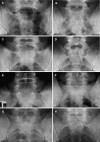Postural sway at ground and bevel levels in subjects with spina bifida occulta
- PMID: 16835732
- PMCID: PMC2200721
- DOI: 10.1007/s00586-006-0178-9
Postural sway at ground and bevel levels in subjects with spina bifida occulta
Abstract
To assess whether the postural function is impaired by comparing the performances in upright standing at ground and bevel levels in adult subjects with spina bifida occulta (SBO). Eighty subjects with SBO (38 with minor type and 42 with major type) and 35 healthy control subjects participated in the study. All participants performed ten tests while standing upright on a platform at ground level (0 degrees, baseline) and on a beveled surface (with their feet in dorsiflexion and plantarflexion at 10 degrees and 20 degrees). Tests were done with their eyes open and closed. The postural sway was examined using a force platform (CATSYS, Danish) that records sway intensity and velocity. Sway intensity and sway velocity were universally associated with group, degree of bevel, open- or closed-eyes condition, and dorsiflexion or plantarflexion after adjusting for age and gender. With respect to sway intensity, the differences of minor or major SBO group were significantly decreased at different bevel degrees when compared with control groups, whereas the differences between minor and major SBO were significant differences at 10 degrees and 20 degrees. With respect to sway velocity, the differences of major SBO group were significantly decreased at different bevel degrees when compared with minor SBO and control groups, whereas the difference in minor SBO was only significant at 0 degrees when compared with control. Group differences (minor SBO vs. control, major SBO vs. control) showed a significant decrease in sway velocity when comparing at 10 degrees than at 0 degrees and at 20 degrees than at 0 degrees. In all subjects with SBO, the sway intensity/velocity values obtained with open eyes and with plantarflexion had lower values, when compared with values obtained with closed eyes and with dorsiflexion. This study supports the hypothesis that SBO impairs control of postural sway in both the resting upright and stressful postures. Our results imply that the larger the bone defect at the lumbosacral midline, the more the group differences in different stressful conditions. Both velocity and intensity were able to reflect the function of the postural sway from our results. This is the first report to add the bevel degree and foot position, as well as visual input as being the part of the study in investigating the postural sway.
Figures




Similar articles
-
Contribution of the multifidus muscle for control of upright posture in subjects with spina bifida occulta.J Sport Rehabil. 2008 Aug;17(3):283-99. doi: 10.1123/jsr.17.3.283. J Sport Rehabil. 2008. PMID: 18708681
-
Impairment of static upright posture in subjects with undifferentiated arthritis in sacroiliac joint in conjunction with elevation of streptococcal serology.J Back Musculoskelet Rehabil. 2009;22(1):33-41. doi: 10.3233/BMR-2009-0217. J Back Musculoskelet Rehabil. 2009. PMID: 20023362
-
Spina bifida occulta: is it a predictor of underlying spinal cord abnormality in patients with lower urinary tract dysfunction?J Neurosurg Pediatr. 2008 Feb;1(2):114-7. doi: 10.3171/PED/2008/1/2/114. J Neurosurg Pediatr. 2008. PMID: 18352778
-
Clinical consequences of spina bifida occulta.J Manipulative Physiol Ther. 1997 Oct;20(8):546-50. J Manipulative Physiol Ther. 1997. PMID: 9345683 Review.
-
Co-existence of spina bifida occulta and lumbosacral transitional vertebra in patients presenting with lower back pain.Reumatologia. 2022;60(1):70-75. doi: 10.5114/reum.2022.114171. Epub 2022 Feb 28. Reumatologia. 2022. PMID: 35645415 Free PMC article. Review.
References
-
- Albano JP, Shannon SG, Alem NM, Mason KT. Injury risk for research subjects with spina bifida occulta in a repeated impact study: a case review. Aviat Space Environ Med. 1996;67:767–769. - PubMed
-
- Alexiev AR. Some differences of the electromyographic erector spinae activity between normal subjects and low back pain patients during the generation of isometric trunk torque. Electromyogr Clin Neurophysiol. 1994;34:495–499. - PubMed
MeSH terms
LinkOut - more resources
Full Text Sources
Medical

